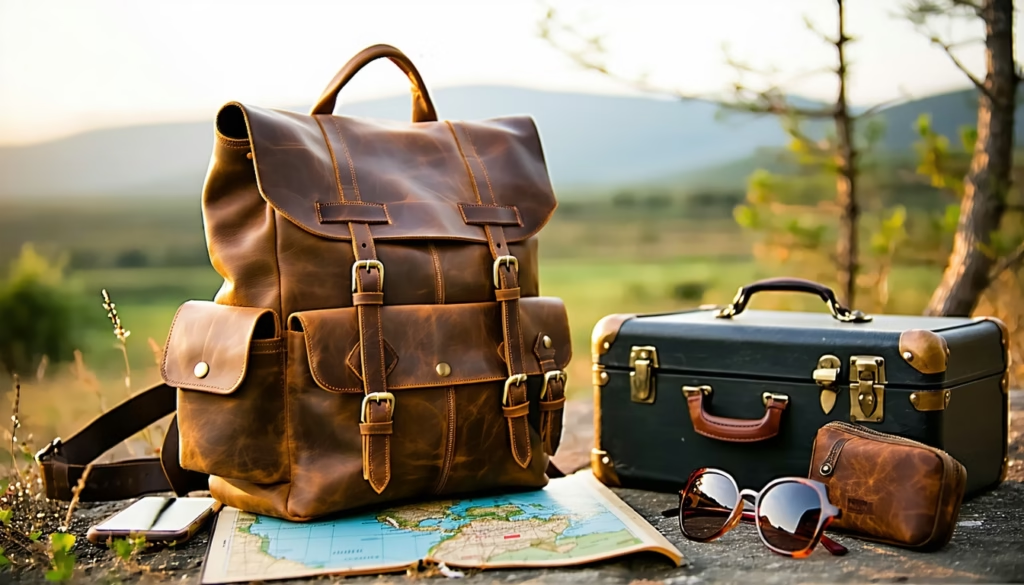Sustainable Leather Weekender Bags That Make A Statement

When we first set out to upgrade our travel gear, we kept coming back to one thing: a leather weekender backpack blends style and sustainability like no other bag can. Packing everything for a quick trip into a sleek, sumptuous hide feels like a fashion statement that also respects our planet. We’re talking about ethically tanned full-grain leather, recycled scraps, and plant-based alternatives—all wrapped into a backpack that can handle the trails, the terminals, and city sidewalks with equal confidence.
By the end of this post, you’ll understand why a sustainably sourced leather pack could be your best travel companion. We’ll walk through the eco-friendly tanning processes, features to prioritize, where to find certified bags, plus simple care tips to keep yours looking sharp for decades. Ready to make your next weekend away truly unforgettable? Let’s dive in.
Leather Weekender Backpack Benefits
Sustainable Style and Substance
Choosing a bag crafted from ethically sourced leather lets us travel responsibly without sacrificing the timeless look that only genuine hide offers. Full-grain hides develop a patina over time—think of it as your bag aging like a fine wine. Meanwhile, veggie-tanned leathers avoid toxic chemicals in favor of natural tannins, so you’re not carrying extra pollutants on your shoulders.
Versatility for Every Trip
Whether we’re hopping on a red-eye or road-tripping down the coast, a backpack silhouette keeps our hands free and weight distributed evenly. We toss in clothes, a toiletry kit, tech gear, and even a pair of shoes. Some designs even fold flat when empty, making them a breeze to store at home or under your hotel bed.
- Fits overhead and under-seat compartments
- Converts from a carry handle to shoulder straps
- Keeps gear organized with dedicated pockets
Long-Lasting Durability
Let’s be honest, we don’t want to replace our travel pack every season. Leather weekender backpacks are built to last—strong seams, reinforced stress points, and robust hardware mean you’ll likely hand yours down someday. Pair that lifespan with eco-friendly sourcing and you’ve reduced waste in two ways: less landfill trash, and fewer replacement purchases.
Types of Sustainable Leather
Vegetable-Tanned Full-Grain
Often regarded as the gold standard, vegetable-tanned full-grain leather is made using plant extracts—like tree bark and fruit compounds—rather than heavy metals. It’s:
- Durable and water-resistant once conditioned
- Free of harmful tanning chemicals
- Prone to rich patina that tells your travel story
Recycled and Upcycled Leather
Some makers salvage leather offcuts or gently worn hides, transforming them into new panels. This approach:
- Cuts down on waste from larger factories
- Offers unique texture variations in every bag
- Often pairs leather with recycled textiles for extra strength
Plant-Based Alternatives
For travelers who want leather’s look with zero animal impact, new bio-leathers use fruit peels, cactus leaves, or mushroom mycelium. These bags:
- Weigh less than traditional hide
- Resist water and stains without toxic coatings
- Arrive at a lower carbon footprint
Curious which option fits your style? Check out our deep dive on eco-friendly weekender backpack materials.
Consider These Backpack Features
Finding the perfect sustainable pack comes down to spotting the right specs. Here’s what we always check before adding a bag to our carry-on collection:
| Feature | Why It Matters |
|---|---|
| Capacity (30–45 L) | Enough room for two outfits, shoes, and tech without overpacking |
| Compartments | Dedicated laptop sleeve, zip pockets, and external stash spots |
| Straps & Handles | Padded shoulder straps, sturdy top handles, and grab rails |
| Leather Type | Full-grain for longevity, recycled for eco impact, veggie-tanned for safety |
| Hardware | Solid brass or stainless steel zippers, buckles, and D-rings |
| Eco Certification | Verifies responsible tanning, fair labor, and reduced emissions |
Capacity and Compartments
A true weekend pack strikes balance. We’ve found 30–45 L is that sweet spot—big enough for essentials, small enough to avoid dragging us down. Look for:
- A laptop sleeve (minimum 15-inch laptop)
- Interior zip and slip pockets for chargers, passports, and keys
- Quick-access exterior pocket for tickets and sunglasses
Carry Options and Comfort
Travel comfort matters. Seek padded, adjustable straps that sit evenly across shoulders. Some packs also include:
- A sternum strap or waist belt for heavy loads
- Top and side grab handles for easy lifts
- Hidden side straps to convert into a tote
If you need more on strap setups, our guide to sternum strap backpack design will help you fine-tune fit.
Durability and Hardware
Cheap zippers or brittle buckles spell disaster mid-trip. We insist on:
- YKK or SBS zippers rated for frequent duty
- Solid metal buckles, D-rings, and rivets
- Reinforced stitching at stress points
Eco-Friendly Manufacturing
Beyond the hide itself, check if the brand:
- Publishes an environmental impact report
- Uses renewable energy in its factories
- Provides fair wages and safe work conditions
That transparency ensures you’re supporting genuine sustainability, not greenwashing.
Maintain Your Leather Backpack
Even the toughest bags need a bit of care. A quick quarterly ritual keeps your pack supple and clean.
Cleaning and Conditioning
- Empty all pockets.
- Wipe surfaces with a soft, damp cloth.
- Apply a small amount of leather cleaner or conditioner.
- Buff gently with a microfiber cloth.
For deep stains or scuffs, follow tips on cleaning weekender backpack. We’ve found conditioning every three months prevents drying and cracking.
Proper Storage
When not in use:
- Stuff the bag with acid-free paper to preserve shape
- Store in a breathable dust bag—cotton works best
- Keep out of direct sunlight to avoid fading
Weatherproofing Tips
Leather isn’t naturally waterproof. To shield from rain:
- Use a quality water repellent spray, testing on a hidden spot first
- Wipe away moisture immediately after exposure
- For heavy downpours, store your pack inside a waterproof bag liner
Learn more about staying dry in our weather resistant weekender backpack guide.
Style Your Weekender Bag
A leather pack should look as good packed as it does empty. Here are our favorite ways to rock one.
Weekend Getaways
For overnight trips:
- Pair with denim and a casual jacket—your bag adds instant polish
- Pack a lightweight travel organizer so your interior stays neat
- Clip on a keychain or luggage tag for a personal touch
Daily Commuting
On workdays:
- Fit in your laptop, notebooks, and lunch container
- Keep your pack upright on transit with a luggage hook
- Coordinate with leather footwear or belt for a cohesive look
If you’re switching between work and play, explore our tips on to weekend backpack.
Day Trips and Errands
For quick missions:
- Carry only the essentials—phone, wallet, water bottle
- Use the external zip pocket for your favorite snacks
- Roll up a lightweight jacket and slip it into the side pockets
Sourcing Sustainable Leather Backpacks
Finding the right maker matters as much as choosing the leather. Here’s where we start our search.
Artisanal and Small-Batch Producers
Local leatherworkers or small brands often:
- Use locally sourced hides with lower transport emissions
- Handcraft each bag to exacting quality standards
- Offer repair services to extend your pack’s life
Certified Eco Labels
Look for certifications like:
- Leather Working Group (LWG): audits the environmental performance of tanneries
- Global Organic Textile Standard (GOTS): for organic linings and trims
- Fair Wear Foundation: ensures fair labor practices
These labels give peace of mind that your purchase supports real sustainability.
Custom-Made Services
For a truly unique pack, brands like Szoneier offer:
- Design consultations to nail your ideal size and pocket layout
- Sample production runs with strict quality checks
- Scalable manufacturing if you ever design a small collection
Custom services tend to cost more upfront, but the result is a lifelong companion handcrafted to your specs.
Frequently Asked Questions
What capacity is best for a leather weekender backpack?
Most travelers aim for 30–45 L. That range fits two outfits, shoes, and electronics without getting bulky.
How often should I condition my leather pack?
Conditioning every three months (or after heavy use) prevents drying and cracking. A little conditioner goes a long way.
Can a leather backpack get wet?
Light rain is okay if you reapply a water repellent spray first. Always wipe off moisture promptly to avoid stains.
Are plant-based leathers durable?
High-quality fruit or mushroom leathers can match hide for durability, but always check the brand’s wear-test results.
How do I clean ink or dye stains?
Use a specialized leather stain remover, following the product instructions. Test on a hidden panel before full application.
What’s the difference between full-grain and top-grain leather?
Full-grain preserves the hide’s outer layer, giving it maximum strength and natural markings. Top-grain is sanded to remove flaws, offering a smoother look but slightly less toughness.
Where can I find straps for convertible backpacks?
If your bag supports conversion, see our advice on convertible weekender backpack straps and conversion clips.
Our Final Takeaways
Investing in a sustainable leather weekender backpack means picking a piece that grows more beautiful with each trip and reflects values you truly stand behind. By prioritizing vegetable-tanned or recycled hides, quality hardware, and certified manufacturing, we’ve found packs that stand the test of time—and travel.
Ready to explore? Start with a simple checklist—capacity, carry comfort, eco-credentials—and you’ll be well on your way to owning a standout bag that tells your unique journey. Happy travels, from all of us!


